Abstract
A cDNA of the C beta 2 gene of the T-cell receptor was used as a probe to investigate the clonal composition of T cells in skin lesions of 5 patients with lymphomatoid papulosis (LyP), a chronic recurrent eruption characterized by morphologically abnormal activated T cells in the cutaneous infiltrate. Clonal T-cell populations, as evidenced by rearranged DNA bands, were demonstrated in the skin lesions of four patients, one of whom has shown clinical progression toward lymphoma. Three of these patients had lesions of type A histology, a type previously shown to be associated with aneuploidy. The remaining patient with clonal lesions appeared to have the same gene rearrangement pattern in DNA obtained from separate lesions taken 11 months apart, providing evidence that the T cells in both sites were derived from the same clone. This patient had lesions of type B histology, which is not associated with aneuploidy. Absence of a rearranged band and deletion or near absence of the 10.8 kb band in Eco RI digests was interpreted as evidence of polyclonal T-cell hyperplasia, accounting for the skin infiltrate of a fifth patient who had a prolonged clinical course without progression to lymphoma. This patient had lesions of type A histology with frequent Ki-1-positive Reed-Sternberg-like cells. Our results show that gene rearrangement analysis provides information that is independent of histology in LyP and may in part explain the variable progression of LyP to lymphoma in 10-20% of patients.
Full text
PDF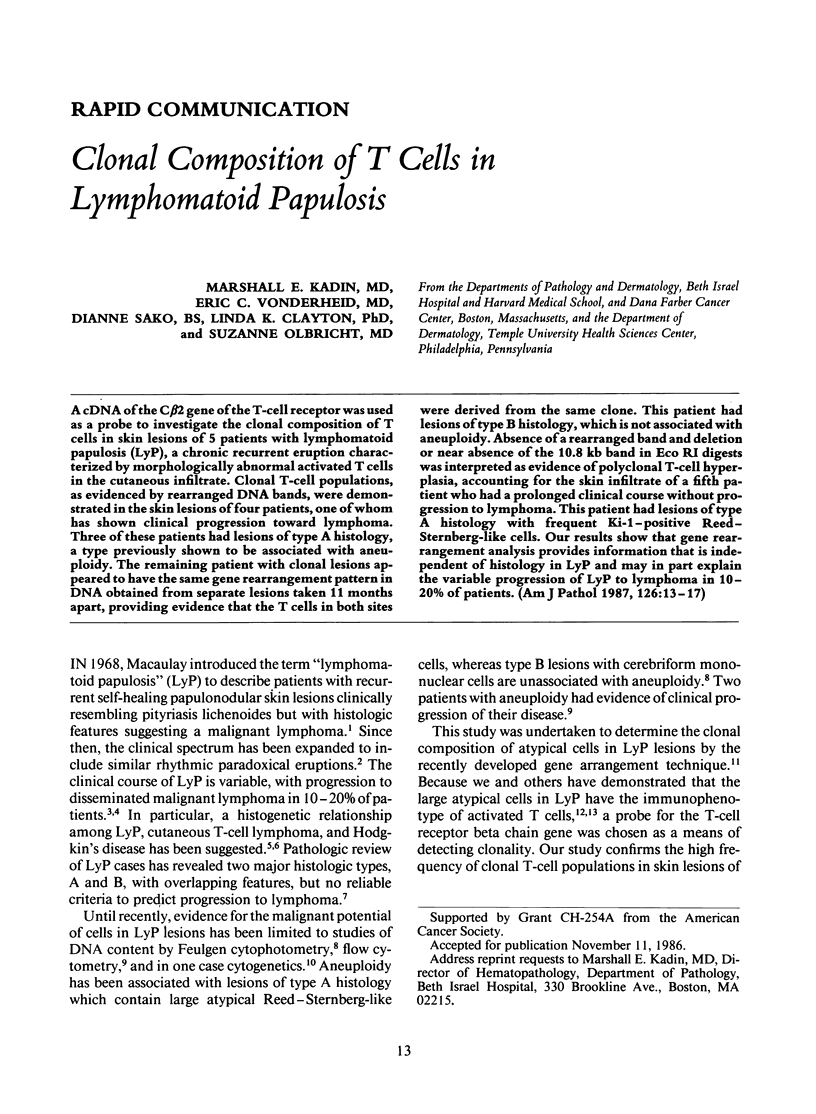
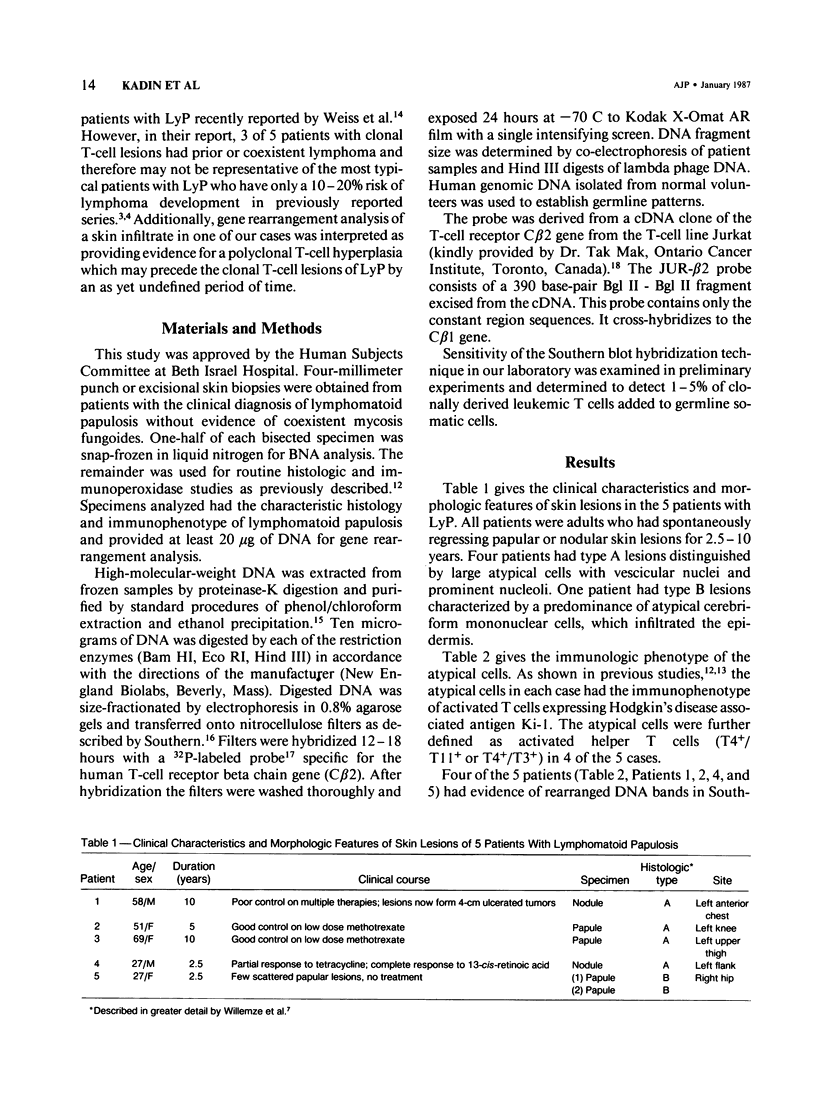
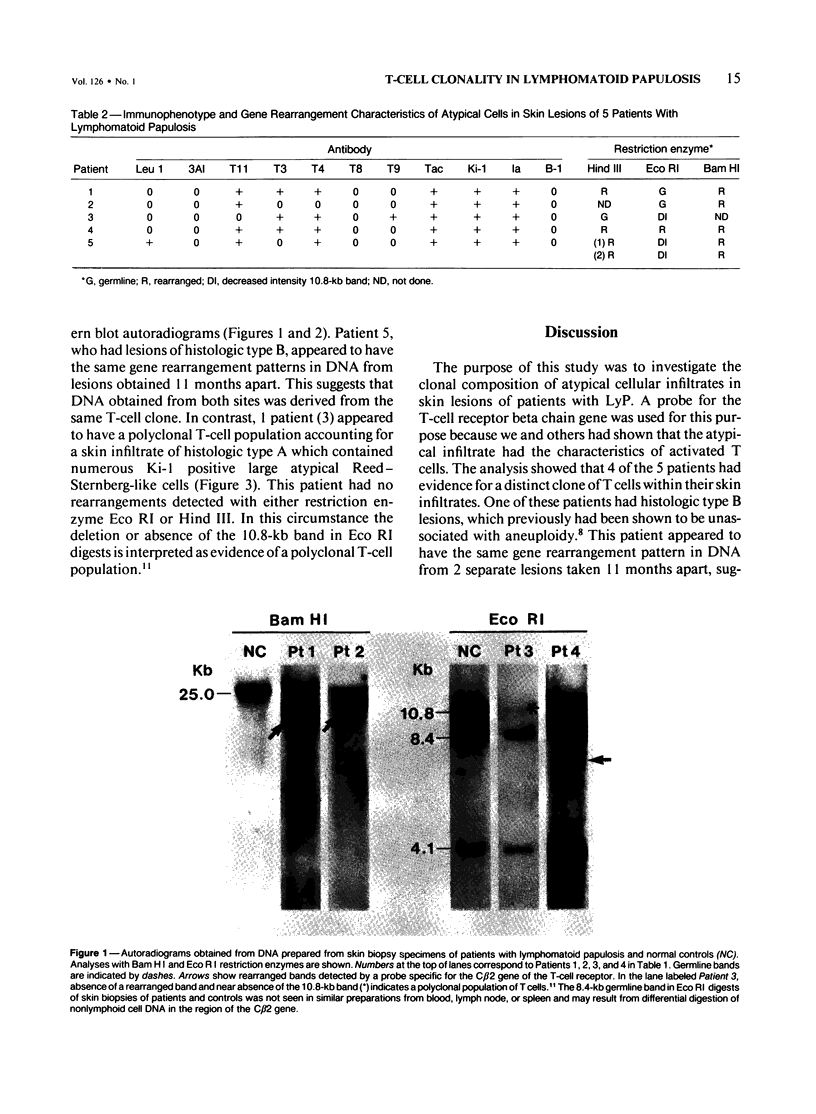
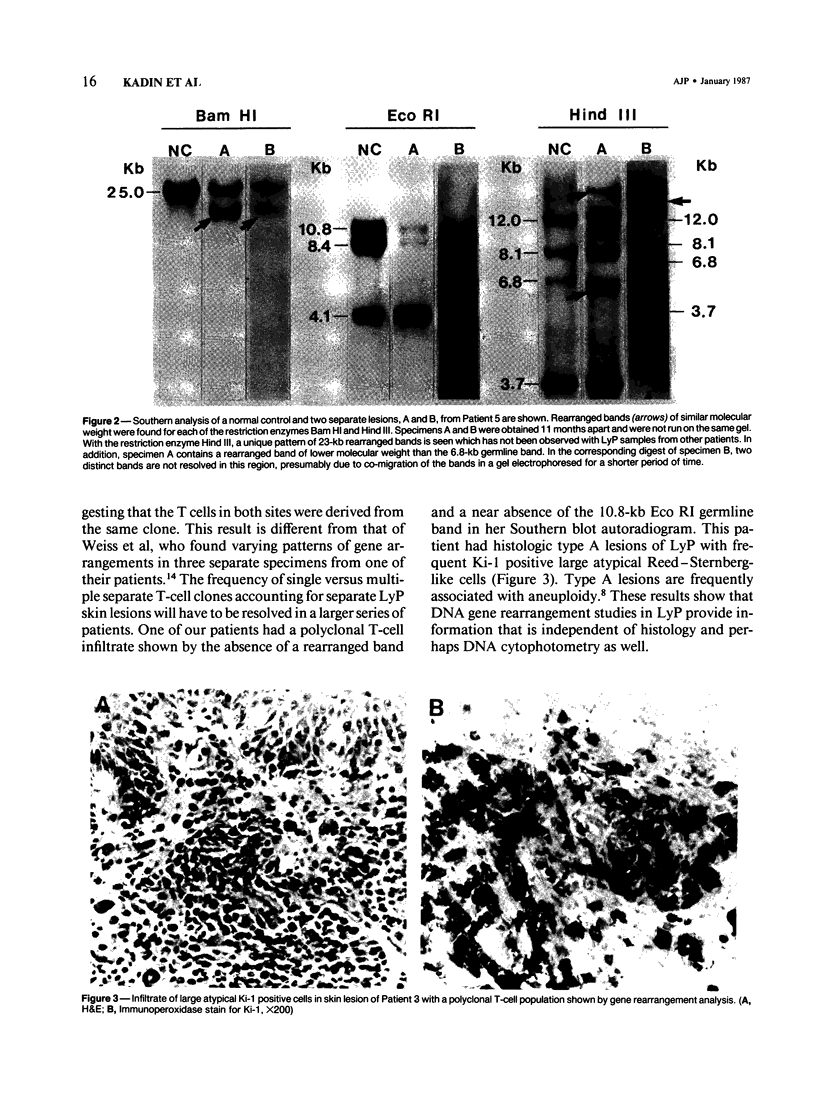
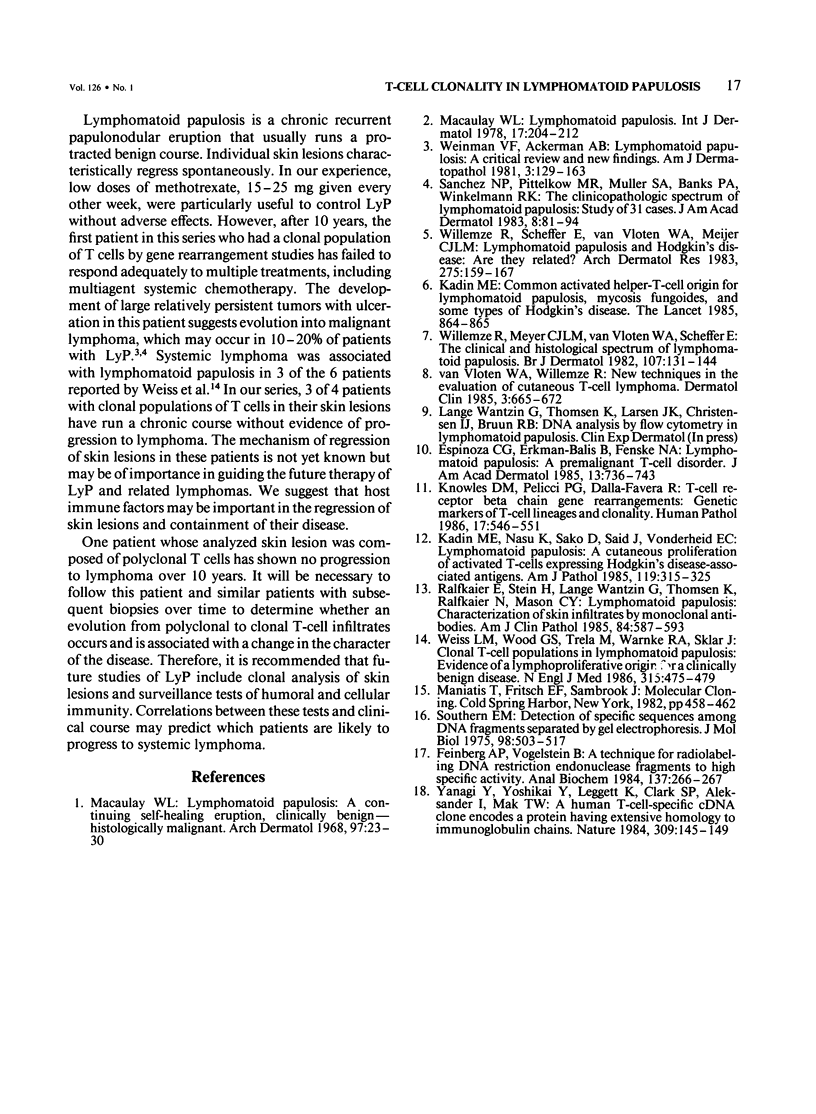
Images in this article
Selected References
These references are in PubMed. This may not be the complete list of references from this article.
- Espinoza C. G., Erkman-Balis B., Fenske N. A. Lymphomatoid papulosis: a premalignant T cell disorder. J Am Acad Dermatol. 1985 Nov;13(5 Pt 1):736–743. doi: 10.1016/s0190-9622(85)70215-0. [DOI] [PubMed] [Google Scholar]
- Feinberg A. P., Vogelstein B. "A technique for radiolabeling DNA restriction endonuclease fragments to high specific activity". Addendum. Anal Biochem. 1984 Feb;137(1):266–267. doi: 10.1016/0003-2697(84)90381-6. [DOI] [PubMed] [Google Scholar]
- Kadin M. E. Common activated helper-T-cell origin for lymphomatoid papulosis, mycosis fungoides, and some types of Hodgkin's disease. Lancet. 1985 Oct 19;2(8460):864–865. doi: 10.1016/s0140-6736(85)90128-x. [DOI] [PubMed] [Google Scholar]
- Kadin M., Nasu K., Sako D., Said J., Vonderheid E. Lymphomatoid papulosis. A cutaneous proliferation of activated helper T cells expressing Hodgkin's disease-associated antigens. Am J Pathol. 1985 May;119(2):315–325. [PMC free article] [PubMed] [Google Scholar]
- Knowles D. M., 2nd, Pelicci P. G., Dalla-Favera R. T-cell receptor beta chain gene rearrangements: genetic markers of T-cell lineage and clonality. Hum Pathol. 1986 Jun;17(6):546–551. doi: 10.1016/s0046-8177(86)80125-3. [DOI] [PubMed] [Google Scholar]
- Macaulay W. L. Lymphomatoid papulosis. A continuing self-healing eruption, clinically benign--histologically malignant. Arch Dermatol. 1968 Jan;97(1):23–30. doi: 10.1001/archderm.97.1.23. [DOI] [PubMed] [Google Scholar]
- Macaulay W. L. Lymphomatoid papulosis. Int J Dermatol. 1978 Apr;17(3):204–212. doi: 10.1111/j.1365-4362.1978.tb06061.x. [DOI] [PubMed] [Google Scholar]
- Ralfkiaer E., Stein H., Wantzin G. L., Thomsen K., Ralfkiaer N., Mason D. Y. Lymphomatoid papulosis. Characterization of skin infiltrates by monoclonal antibodies. Am J Clin Pathol. 1985 Nov;84(5):587–593. doi: 10.1093/ajcp/84.5.587. [DOI] [PubMed] [Google Scholar]
- Sanchez N. P., Pittelkow M. R., Muller S. A., Banks P. M., Winkelmann R. K. The clinicopathologic spectrum of lymphomatoid papulosis: study of 31 cases. J Am Acad Dermatol. 1983 Jan;8(1):81–94. doi: 10.1016/s0190-9622(83)70011-3. [DOI] [PubMed] [Google Scholar]
- Southern E. M. Detection of specific sequences among DNA fragments separated by gel electrophoresis. J Mol Biol. 1975 Nov 5;98(3):503–517. doi: 10.1016/s0022-2836(75)80083-0. [DOI] [PubMed] [Google Scholar]
- Weinman V. F., Ackerman A. B. Lymphomatoid papulosis. A critical review and new findings. Am J Dermatopathol. 1981 Summer;3(2):129–163. doi: 10.1097/00000372-198100320-00004. [DOI] [PubMed] [Google Scholar]
- Weiss L. M., Wood G. S., Trela M., Warnke R. A., Sklar J. Clonal T-cell populations in lymphomatoid papulosis. Evidence of a lymphoproliferative origin for a clinically benign disease. N Engl J Med. 1986 Aug 21;315(8):475–479. doi: 10.1056/NEJM198608213150802. [DOI] [PubMed] [Google Scholar]
- Willemze R., Meyer C. J., Van Vloten W. A., Scheffer E. The clinical and histological spectrum of lymphomatoid papulosis. Br J Dermatol. 1982 Aug;107(2):131–144. doi: 10.1111/j.1365-2133.1982.tb00331.x. [DOI] [PubMed] [Google Scholar]
- Willemze R., Scheffer E., Van Vloten W. A., Meijer C. J. Lymphomatoid papulosis and Hodgkin's disease: are they related? Arch Dermatol Res. 1983;275(3):159–167. doi: 10.1007/BF00510047. [DOI] [PubMed] [Google Scholar]
- Yanagi Y., Yoshikai Y., Leggett K., Clark S. P., Aleksander I., Mak T. W. A human T cell-specific cDNA clone encodes a protein having extensive homology to immunoglobulin chains. Nature. 1984 Mar 8;308(5955):145–149. doi: 10.1038/308145a0. [DOI] [PubMed] [Google Scholar]
- van Vloten W. A., Willemze R. New techniques in the evaluation of cutaneous T-cell lymphoma. Dermatol Clin. 1985 Oct;3(4):665–672. [PubMed] [Google Scholar]





